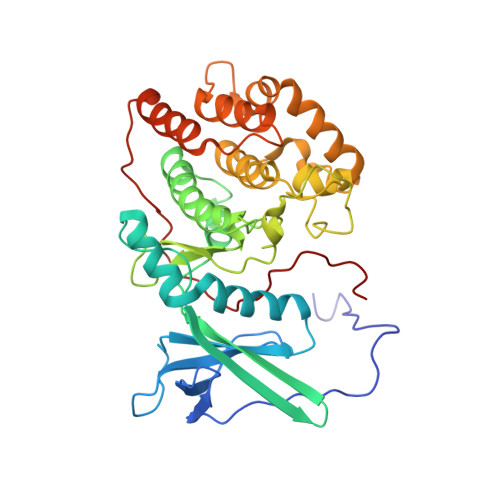NMR Solution Structure of Human Vaccinia-related Kinase 1 (VRK1) Reveals the C-terminal Tail Essential for Its Structural Stability and Autocatalytic Activity.
Shin, J., Chakraborty, G., Bharatham, N., Kang, C., Tochio, N., Koshiba, S., Kigawa, T., Kim, W., Kim, K.T., Yoon, H.S.(2011) J Biol Chem 286: 22131-22138
- PubMed: 21543316
- DOI: https://doi.org/10.1074/jbc.M110.200162
- Primary Citation of Related Structures:
2LAV - PubMed Abstract:
Vaccinia-related kinase 1 (VRK1) is one of the mitotic kinases that play important roles in cell cycle, nuclear condensation, and transcription regulation. Kinase domain structures of two other VRK family members (VRK2 and VRK3) have been determined previously. However, the structure of VRK1, the most extensively studied and constitutively active VRK member, is yet to be characterized. Here, we present the nuclear magnetic resonance (NMR) solution structure of a catalytically active form of human VRK1 with its extended C-terminal tail (residues 1-361). The NMR structure of human VRK1 reveals that the C-terminal tail orients toward the catalytic site and forms a number of interactions that are critical for structural stability and catalysis. The role of this unique C-terminal tail was further investigated by deletion mutant studies where deletion of the terminal tail resulted in a dramatic reduction in the autocatalytic activity of VRK1. NMR titration studies carried out with ATP or an ATP analog confirm that ATP/ATP analogs interact with all of the crucial residues present in important motifs of the protein kinase such as the hinge region, catalytic loop, DYG motif, and thereby suggest that the catalytic domain of VRK1 is not atypical. In addition to the conventional interactions, some of the residues present on the extended C-terminal tail also interact with the ligands. These observations also substantiate the role of the extended C-terminal tail in the biological activity of VRK1.
Organizational Affiliation:
School of Biological Sciences, Nanyang Technological University, Singapore 637551.














